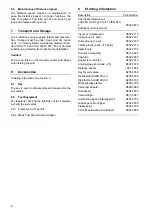
2
CONTENTS
Page
Design of the Protective Suit, Fig. 1
3
1
Designation, Marking
4
1.1
Designation
4
1.2
Marking
4
2
Application
4
3
Design of the Protective Suit
4
3.1
Design
4
3.2
Operation
4
3.3
Technical Data
4
3.3.1 Mechanical Properties
4
3.3.2 Chemical Properties
5
4
Use
5
4.1
Clothing
5
4.2
Donning the Protective Suit
5
4.3
Removing the Protective Suit
6
4.4
Disposal of Contaminated Suits
6
5
Care and Maintenance
6
5.1
Cleaning
6
5.2
Disinfection
6
5.3
Maintenance
6
Page
5.4
Tightness Test of the Protective Suit
7
5.5
Checks in Case of Leaks
7
5.6
Visual Checks
7
5.7
Maintenance Intervals
7
5.8
Repairs
7
6
Maintenance Work
7
6.1
Suit Valves
7
6.2
Zipper
7
6.3
Replacing the Lens
7
6.4
Replacing the Gloves
7
6.5
Replacing the Boots
7
6.6
Maintenance of the Distance Spacer
8
7
Transport and Storage
8
8
Accessories
8
8.1
Key
8
8.2
Test Equipment
8
9
Ordering Information
8
The chemical protective suit described in this manual is in accordance with Directive 89/686/EEC.
Notice!
Like any piece of complex equipment, this MSA AUER product will do the job it is designed to do only, if it is
used and serviced in accordance with the manufacturer’s instructions. This manual must be carefully read by all
individuals who have or will have responsibility for using or servicing this product.
The warranties made by MSA AUER GmbH with respect to this product are voided if the product is not used
and serviced in accordance with the instructions in this manual. Please protect yourself and your employees by
following them.
Before choosing and using this product, it is required to assess whether it is suitable for the application in-
tended.
Selection and use are beyond the control of MSA AUER GmbH. Therefore, the liability of MSA AUER GmbH
covers only the steady quality of this product.
The above does not alter statements regarding the warranties and conditions of sale and deliveries of
MSA AUER GmbH.
Important
Check regularly that your protective suit is tight and that no parts are missing. Only then it will give you proper
protection!
To avoid electrostatic charging, moisten the outside of the protective suit with water prior to entering explosive
areas and while in such an area keep the suit moist.
Tightness tests should be made at least every six months. The AUER testing equipment for suits and valves is
available for that purpose. If you wish these tests to be carried out for you please contact the MSA AUER cus-
tomer service:
MSA AUER GmbH, European Repair Center, Thiemannstr.1, D-12059 Berlin
Phone:
+49 [30] 6886-555
F A X
+49 [30] 6886-1517






































